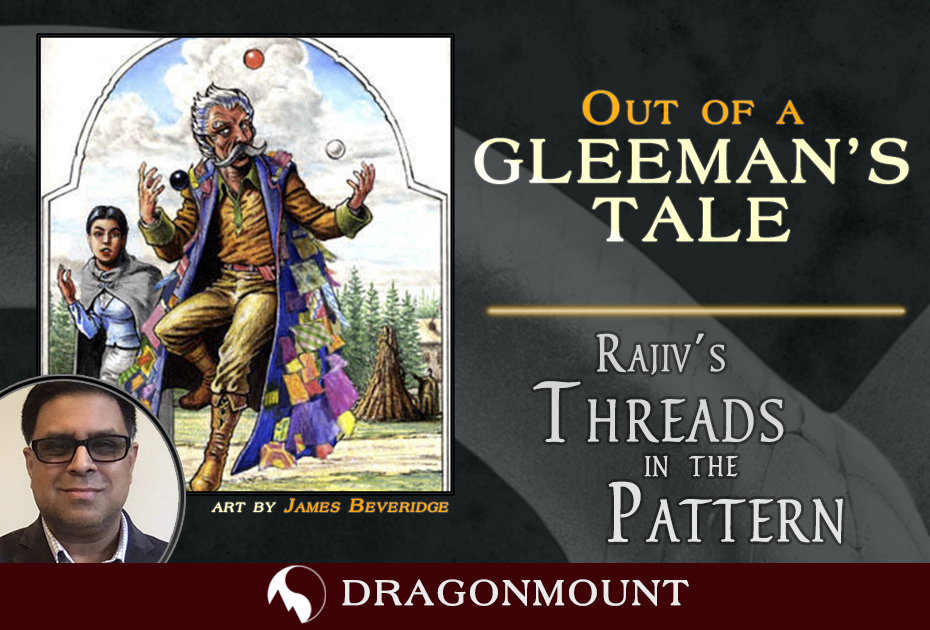
Rajiv Moté is Dragonmount’s book blogger with a lens on the craft of fiction writing. When he’s not directing software engineers, he writes fiction of his own, which can be found catalogued at his website.
I love metafiction: stories that say something about the nature of stories. Stories that are aware of themselves as stories, but still manage to pull us into their reality. Recently in Marvel Studios’ Loki on Disney+, the Norse god of mischief was yanked outside of space and time by the mysterious Time Variance Authority, an organization that made sure characters don’t stray beyond a preordained plot called “The Sacred Timeline.” The TVA bureaucrats and stormtroopers violently edited the story when characters tried to deviate. The ensuing metafictional adventure explored the virtues of predestination versus free will, order versus chaos, a universe versus a multiverse--and who gets to control the narrative.
It reminded me of The Wheel of Time. Robert Jordan’s epic builds a universe of cyclic history, without beginning or end, that encompasses all the stories that were and could be, and sets the parameters for how its characters must behave.
All Stories Are Part of the Pattern
Quote"But in its loftiest sense syncretism is the acknowledgement that a single Tradition runs through and nurtures all religion, all learning, all philosophy." -- Foucault’s Pendulum, Umberto Eco
In Umberto Eco’s novel about a conspiracy theory that took on a life of its own, syncretic thinking drives the impulse to see similarities in stories and legends as proof of an occult, underlying connection. It is fuel for cork boards of evidence joined by colored string and push-pins, and the rapturous feeling that one is delving into arcana to find the true, hidden source of what the uninitiated see as coincidence. Syncretism is meta-storytelling: an irresistible urge to see cohesion in unconnected stories.
Quote“The Wheel of Time turns, and Ages come and pass, leaving memories that become legend. Legend fades to myth, and even myth is long forgotten when the Age that gave it birth comes again.” The Wheel of Time, Robert Jordan
The Wheel of Time’s ambitious conceit is that its story is in conversation with all stories. History, legends, and mythology are echoes of each other in a great cycle. Comparing elements of the story with other myths, legends, history, or current events feeds the notion that it’s all one big pattern of recurring motifs--history that rhymes, as Mark Twain supposedly said.
Quote
“I have stories, and I will give them to you. I will make them come alive before your eyes… Tales of Artur Paendrag Tanreall, Artur Hawkwing, Artur the High King, who once ruled all the lands from the Aiel Waste to the Aryth Ocean, and even beyond. Wondrous stories of strange people and strange lands, of the Green Man, of Warders and Trollocs, of Ogier and Aiel. The Thousand Tales of Anla, the Wise Counselor. ‘Jaem and the Giant-Slayer.’ How Susa Tamed Jain Farstrider. ‘Mara and the Three Foolish Kings.’”
“Tell us about Lenn,” Egwene called. “How he flew to the moon in the belly of an eagle made of fire. Tell about his daughter Salya walking among the stars.”
“Old stories, those,” Thom Merrilin said… “Stories from the Age before the Age of Legends, some say. Perhaps even older. But I have all stories, mind you now, of Ages that were and will be. Ages when men ruled the heavens and the stars, and Ages when man roamed as brother to the animals. Ages of wonder, and Ages of horror. Ages ended by fire raining from the skies, and Ages doomed by snow and ice covering land and sea. I have all the stories, and I will tell all stories. Tales of Mosk the Giant, with his Lance of fire that could reach around the world, and his wars with Elsbet, the Queen of All. Tales of Materese, the Healer, Mother of the Wondrous Ind.” -- “The Gleeman,” The Eye of the World
Ann Landers, John Glenn, Sally Ride, nuclear annihilation, climate catastrophe, Moscow and its ICBMs, Queen Elizabeth, Mother Theresa--they all become Gleeman’s tales in the Third Age, where the legend of King Arthur is historical fact. The land abounds with ancient artifacts, from a Mercedes hood ornament to a radioactive spire, pointing to continuity between our real world and the story world. With enough turnings of the Wheel of Time, all stories are real.
The Wheel Is the Storyteller
In Robert Jordan’s cosmology, the Wheel is the ultimate storyteller. It spins out character threads to weave the Pattern of the plot in recurring motifs. And while Jordan created no multiversal bureaucracy to manage his Sacred Timeline, he does have the concept of ta’veren.
Quote
“You see, the Wheel of Time weaves the Pattern of the Ages, and the threads it uses are lives. It is not fixed, the Pattern, not always. If a man tries to change the direction of his life and the Pattern has room for it, the Wheel just weaves on and takes it in. There is always room for small changes, but sometimes the Pattern simply won’t accept a big change, no matter how hard you try.”
“But sometimes the change chooses you, or the Wheel chooses it for you. And sometimes the Wheel bends a life-thread, or several threads, in such a way that all the surrounding threads are forced to swirl around it, and those force other threads, and those still others, and on and on. That first bending to make the Web, that is ta’veren, and there is nothing you can do to change it, not until the Pattern itself changes. The Web--ta’maral’ailen, it’s called--can last for weeks, or for years. It can take in a town, or even the whole Pattern.” -- “Web of the Pattern,” The Eye of the World
Just as the author puts the main characters on a journey, pulling a widening blast radius of other characters and events in their wake, the Wheel spins ta’veren to set the story in motion. The protagonists seem to have an awareness of entering the plot of a story. They contrast what “real life” is, compared with stories. They self-deprecatingly chide themselves for playing the hero in some gleeman’s tale right before doing exactly that.
Quote
Briefly he wondered how Master Luhhan knew the creatures were Trollocs, but it was a fleeting thought. If Tam could recognize them, there was no reason why Haral Luhhan could not.
“All the stories are real,” he muttered.
“So it seems, lad,” the blacksmith said. “So it seems.” -- “Out of the Woods,” The Eye of the World
“Heroes in the stories never had to sleep in haystacks, or under hedges. But it was not easy to pretend, anymore, that he was a hero in a story, even for a little while.” -- “The Last Village,” The Eye of the World
The Dharma of the Wheel
But what of free will, in a universe where a cosmic author is spinning out the plot? As Loial’s description implies, the Wheel tolerates minor variations, but prevents large deviations. Those who are ta’veren have less freedom than others, and we see characters like Cadsuane and Tuon resisting ta’veren effects with great effort. But predestination abounds in The Wheel of Time. There are prophecies, Foretellings, prophetic dreams, true answers from dangerous fae-folk, and of course Min’s visions. All are glimmers of the Pattern, and none can be averted.
Many of the character arcs revolve around the characters’ struggle with predestination. Rand, Mat, and Perrin each rail in their own way against what they must become. Min is a Cassandra, who can see the approach of doom, but can do nothing to avert it. Aviendha resists first a personal destiny to love Rand, and later the ultimate, tragic fate of her entire people. Moiraine is the heroic exemplar of someone who courageously faces whatever fate decrees, no matter the personal cost, and Lan is an example of someone who resigns himself to what he believes is his doom, but should really have more faith in the benevolence of the Wheel. Nynaeve is someone who cannot reach her potential while she resists the role spun for her, but once she surrenders to it, becomes one of the most powerful characters in the epic.
While there is no “religion” in The Wheel of Time, there is a moral law to the universe: align thyself to the Pattern. This is similar to the Hindu concept of dharma, where the cosmic Truth is made manifest through proper behavior in the social order.
Quote
“You’re not one of my soldiers. But you need to make some decisions. In the days coming, you’ll need to have a side and you’ll need to know why you’ve chosen it. That’s all I’ll say on the matter.” -- "Old Advice," The Gathering Storm
“The choice isn’t always about what you do, son, but why you do it. When I was a soldier, there were some men who fought simply for the money. There were others who fought for loyalty—loyalty to their comrades, or to the crown, or to whatever. The soldier who dies for money and the soldier who dies for loyalty are both dead, but there’s a difference between them. One death meant something. The other didn’t.
I can’t imagine that the Pattern won’t give you some peace, considering the service you’re doing for us all. But you’re a soldier going to war, and the first thing a soldier learns is that you might die. You may not be able to choose the duties you’re given. But you can choose why you fulfill them. Why do you go to battle, Rand?” -- "The One He Lost," The Gathering Storm
There are echoes in these scenes of the Bhagavad Gita, where just before the great battle against kin and former teachers, the warrior Arjun despairs of his purpose. The Lord Krishna reveals his divinity to Arjun, and teaches him to align himself to his dharma, which is both duty and fate, through which he will know both peace of mind and singularity of purpose. Those who submit to the will of the Wheel become aligned with a benevolent cosmos. Ta’veren who do so become unstoppable.
There is a delightful parallel between Mat embracing his ta’veren-hood and Lloyd Alexander’s character Taran, who learns a lesson from Llonio, the luckiest man in Prydain.
Quote
“Coincidence is how being ta’veren works,” Verin said. “You find a discarded object that is of great use to you, or happen to meet an individual at just the right time. Random chance randomly works in your favor. Or haven’t you noticed?” She smiled. “Care to throw some dice on it?” -- “The Death of Tuon,” The Gathering Storm
“Secret?” replied Llonio. “Have you not already guessed? Why, my luck’s no greater than yours or any man’s. You need only sharpen your eyes to see your luck when it comes, and sharpen your wits to use what falls into your hands… Trust your luck, Taran Wanderer. But don’t forget to put out your nets!” -- “The Weir,” Taran Wanderer by Lloyd Alexander
“He pulled out a knife, flipping it. Then, on a whim, he tossed it behind him without looking. He heard a soft screech, then turned to see a rabbit slump to the ground, speared by the idly thrown knife. He smiled, then turned back to the river. There, he noticed something caught between two large river stones along the shore. It was an overturned cooking pot, with a copper bottom, barely used, only dinged on the sides a couple of times.” -- “A Rabbit for Supper,” Towers of Midnight
On the other side, the Dark One seeks to corrupt the Pattern and break the Wheel of Time. The Darkfriends see the Wheel's predestination as tyranny, and believe the Dark One will weave them new fates of power and stature. To the servants of the Shadow, the Pattern can be rewritten if their master wins.
Quote
“I might have been the one. How could I be sure otherwise? I can channel; I’m strong. What said I was not the Dragon Reborn? All I had to do was fulfill just one of the Prophecies.”
“Like managing to be born on the slopes of Dragonmount?” Rand said coldly. “That was the first Prophecy to be met.”
Taim’s mouth quirked again… “Victors write history. Had I taken the Stone of Tear, history would have shown I was born on Dragonmount, of a woman never touched by a man, and the heavens opened up in radiance to herald my coming. The sort of thing they say about you, now.” -- “A New Arrival,” Lord of Chaos
The Hands on the Wheel
Understanding the cosmology of The Wheel of Time as both metafiction and a benevolent force in the story world, gives us insight into one of the epic’s most mysterious characters. Nakomi appears as a middle-aged Aiel woman who has two scenes in the entire story. The first time, she shares Aviendha’s fire and tea as the younger woman makes her way to Rhuidean for her final test as a Wise One. She asks seemingly innocent questions about the fate of the Aiel in this new, changed world, something Aviendha ponders deeply when Rhuidean reveals that clinging to the old ways leads the Aiel to ignominy and extinction. The second time Nakomi appears is to make sure that Rand carries Moridin’s body down from Shayol Ghul, the act that allows Rand to live on beyond the Last Battle.
Both of Nakomi’s appearances involve decisions pivotal to the Fourth Age, the Age after the Dark One is locked safely away until the Age of Legends comes again. The Pattern is not threatened by the Fourth Age fates of the Aiel or Rand al’Thor. But there is a point of decision between suffering or grace, and Nakomi tips the balance to the latter. If the Creator set everything in motion, but takes no part in the events of the world, and the Wheel spins an endlessly rhyming Pattern, then perhaps Nakomi is the compassionate principle in this divine trinity. Perhaps Nakomi is the lone Norn at the spinning wheel, who makes sure the story has a happy ending.













Recommended Comments
Join the conversation
You can post now and register later. If you have an account, sign in now to post with your account.
Note: Your post will require moderator approval before it will be visible.